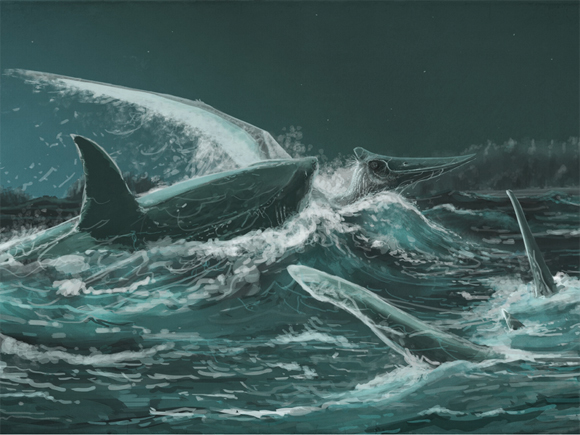Prehistoric Sharks and Fish Fed on Pterosaurs
Prehistoric Sharks and Fish Fed on Pterosaurs
A series of tell-tale bite marks discovered on the preserved forelimb (wing) of a species of pterosaur reveal that in the Late Cretaceous, prehistoric sharks and other types of fish fed on flying reptiles. This remarkable discovery, not only helps palaeontologists to infer an aspect of shark and fish feeding behaviour, but the preserved striations have permitted researchers to identify the species of shark likely to have caused the bite marks and narrowed down the other fish culprit to the genus level.
Scientists Have Discovered a Pterosaur Bone that was Scavenged by a Shark

Picture credit: Mark Witton/Palaios
Pterosaur Fossil from Alabama
A single metacarpal bone, identified as coming from a Pteranodon (P. longiceps) discovered in Alabama exhibits serrated teeth marks on the surface of the bone and a second set of unserrated teeth marks unlike those of any contemporary shark species. Writing in the academic journal “Palaios”, researchers from the New Jersey State Museum and the Geological Survey of Alabama report on the fossil bone from the Mooreville Chalk of Dallas County, Alabama. The fossil is approximately 83 million years of age (Campanian faunal stage of the Late Cretaceous), a time when this part of the United States was covered by a shallow, tropical sea (the Mississippi Embayment).
Squalicorax kaupi
The feeding marks associated with a shark species have been identified as Squalicorax kaupi, a lamniform shark, part of a dominant Mesozoic group, before being replaced by a more modern shark biota (carcharhiniform sharks), as a result of the Cretaceous mass extinction event.
To read more about the marine biota turnover that occurred at the end of the Cretaceous: Modern Shark Diversity Strongly Influenced by the End Cretaceous Extinction Event.
Sword-eel Fish Feeds on a Pterosaur
The researchers conclude that the other feeding traces on the pterosaur metacarpal were made by a Sword-eel fish (saurodontid), such as Saurodon or Saurocephalus. These bony fish were large predators, with some specimens measuring more than two metres in length. They had long, powerful bodies and the lower jaw was elongated and larger than the upper jaw. It is likely that these types of fish were active hunters usually feeding on smaller fish and squid. However, in this instance, both the shark and the bony fish appear to have scavenged on the remains of a pterosaur.
The authors of the scientific paper, Dana J. Ehret (New Jersey State Museum) and T. Lynn Harrell Jr (Geological Survey of Alabama), hypothesise that the fossil bone represents a flying reptile that either fell into marine waters or washed out from nearshore areas and was then scavenged.
The Teeth in the Sword-eel Fish Jaw Match the Feeding Traces on the Fossil Bone
Picture credit: Palaios
A spokesperson from Everything Dinosaur commented:
“Pterosaur fossil remains are extremely rare in the Late Cretaceous marine chalks of Alabama. The few specimens that have been found are very fragmentary in nature. To be able to infer feeding behaviour on the remains of a Pteranodon is quite remarkable.”
Visit the Everything Dinosaur website: Everything Dinosaur.


